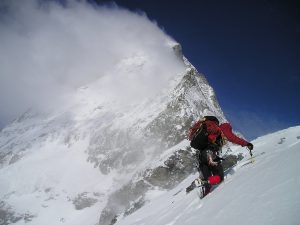When 37-year old Argentinian mountain climber Natalia Martinez set out to climb Mount Logan in Kluane National Parke and Reserve on April 24, 2017, she had a lot on her mind. Natalia was summiting the mountain on her own, somewhat of a rarity for the highest peak in North America. Moreover, she had chosen one of the most technical routes up the mountain. Natalia was keenly aware that hurricane-force winds and debilitating snowstorms stopped two other climbers during their ascent to the same peak in 2008. But, what she didn’t anticipate were the full range of leadership skills she’d need to rely on during her fateful trip.
Eleven days into her trek, Natalia abruptly awoke when a strong earthquake (6.2 on the Richter scale) struck. She was on a glacier, was it collapsing she wondered? Two hours later a second powerful earthquake rocked the mountain, and in an instant, Natalia’s dream of summiting the mountain was over.
With possible earthquakes and avalanches to follow, it was equally perilous for Natalia to continue with her ascent, as it would be for her to make her way back to basecamp. Her expedition quickly turned into a rescue mission. Harsh weather, hurricane-force winds and heavy snowfall hampered rescue efforts, and Natalia had to call on all of her mountaineering, survival and leadership skills waiting for help to arrive.
Here are four of the valuable leadership lessons we can learn from this courageous mountain climber:
1. Preparation
Natalia spent two years in Patagonia preparing and training for the rigours of her solo trek. As an experienced mountain guide and climber, she was mentally, emotionally and physically equipped to deal with Mount Logan’s harsh weather and quickly changing climatic conditions.
While Natalia hadn’t anticipated earthquakes or the subsequent avalanches, her preparation was the cushion she needed to endure the ordeal. She had adequate equipment, food, and fuel to withstand nearly four grueling and lonely days on the mountain while waiting for help to arrive. Helicopter pilot, Ian Pitchforth described that Natalia was “packed and ready” when the rescue team arrived. Scott Stewart, the Parks Canada rescue coordinator, said she “did everything right” which included her training, her equipment and the mountaineering insurance she had purchased.
Business and community leaders need to prepare mentally, emotionally and intellectually for a variety of unforeseen disruptions, including those in the economy, technology, organizational, and rapidly changing customer and employee expectations. In the world of work, the proper preparation may make the critical difference between success and failure. As philosopher Seneca wrote: “Luck is what happens when preparation meets opportunity.” Leaders can no longer afford to leave their futures to chance.
2. Calculated Risk-Taking
Trapped two-thirds up the mountain when the earthquakes hit, Natalia realized she needed to move her camp to a higher altitude to avoid further avalanches of snow, glacial ice and rock. She made the calculated risk of moving beyond the avalanche zone, requiring she expose herself to snowstorms with 100 km an hour winds and temperatures dipping to -30°C.
In the volatile, uncertain and complex world, leaders are always making calculated trade-offs and managing their organizations for risk. Planning requires foresight, courage and the need to adapt quickly and learn from early failures, allowing them to capitalize on their learning. Leaders who develop proactive contingency plans and see failure as experimentation also bank resources that their organizations can use in challenging times, ensuring their teams are successful in the long-term.
3. Mindset
Natalia focused on what mattered most, her family and friends, including her partner (also a climber), Camilo Rada to keep her morale high during the four days she spent waiting for help to arrive. She was keenly aware of her emotional state, “The last day before the rescue, my mind was eating me. I was more sensitive to every sound. I felt alert to every danger”. She engaged in positive self-talk to help remain calm despite the cold and lack of sleep. “Come on, you can do it, you can do it. Just a few more days.” She kept herself busy and healthy by focusing on what she could do: drinking, eating, tending to her tent and making a wall to stop the wind from howling through her camp.
Self-awareness, a hallmark of emotional intelligence is key to leadership success. The ability to name and monitor one’s emotions in real time unlocks core emotional and mental capabilities. Without this essential ingredient, leaders lack insight into their fears and vulnerabilities, which strips them of their sound decision-making.
4. Attract a Diverse Team
While Natalia mounted a solo trek, she was surrounded by a team who she heavily relied upon. This team included The Royal Geographic Society who financed her trip, the Parks Canada/Kluane National Park and Reserve’s Public Safety Team, the outfitter Icefield Discovery Tours and her partner Camilo, with whom she spoke to regularly via satellite phone while she waited for help to arrive. Without this extensive team, neither Natalia’s expedition nor her rescue would have been possible.
Every leader has their unique set of strengths, weaknesses and consequently, they have their biases and blind spots. Self-aware leaders naturally surround themselves with diverse teams of people who have complementary strengths to augment their perspective. Team diversity also combats the perils of groupthink that so many teams succumb. Workforce diversity makes good business sense. Companies who embrace cultural diversity report higher rates of innovation.
Tectonic forces, brutally cold temperatures, and blinding snowstorms will test few leaders. All leaders will be tested on their proverbial mountain and will face unpredictable forces that challenge their courage and mental fortitude in this new world of work. There are leadership lessons everywhere.



